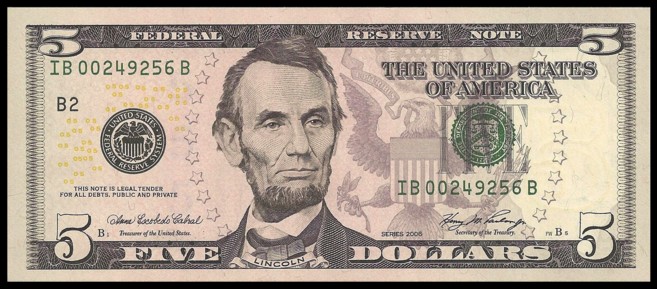1907 5 Dollars Legal Tender Note
1907 was a year that probably went by as mundane as most others, but there were quite a few things that happened then: The first automobile taxicabs began operating in New York City. Also in New York, the ship Lusitania set a record Atlantic crossing in just under 5 days on September 12th. Women were granted the right to vote in Norway, while in the US, women would have to wait until 1920 for the their right to vote. In November Oklahoma was inaugurated as the 46th state, while in Seattle, Washington, the worlds famous Pikes Market was dedicated. Future Hollywood stars Barbara Stanwyk, Buster Crabbe, Katharine Hepburn and John Wayne were born, and “Mutt and Jeff” premiered as the first successful daily newspaper comic strip. Then on December 31, 1907 the famous Ball dropped in Times Square for the very first time.
That was over 100 years ago, and it was a completely different world, as further evidenced by this $5 Large Sized US Note. The design of this note, commonly known as the “Woodchopper,” is a favorite among collectors. This note shows the transition from an older style to a newer design concept that was adopted in the 1910’s.


1914 5 Dollars Federal Reserve Note
Federal Reserve Notes were first issued in 1914, and are the only type of paper money that the United States prints today. All other banknotes issued by the US still remain legal tender, but only the Federal Reserve notes are still in production. This five dollar note was initially printed with red serial numbers and a red Treasury Seal but soon were changed to blue. The Treasury Seal and Serial Numbers changed to green in 1928. Note that the Federal Reserve Seal has both the number and it’s designate letter in the center of the seal. This letter was dropped for the small size 1928 and 1928A series FRN’s and only the number was printed. Beginning with the 1928 B series the letter replaced the number. There are two vignettes on the back of this note. The left one is by Charles Schussele and is called “Columbus’ Discovery of Land”, the same as the one found on the front of the 1917 large size 1 dollar United States (Legal Tender) banknote towards the top of this page. The vignette on the right side on the back of this note depicts the “Landing of the Pilgrims”.


1928 5 Dollars Legal tender Note
Next up is another $5 United States Note, but this time it is a 1928 small sized note. Notice the red Seal, indicating the note is a US (aka Legal Tender) Note. The size of all banknotes became smaller beginning in 1928.


1928 5 Dollars Federal Reserve Note “Numerical”
Here’s a 1928 Federal Reserve 5 Dollar note. You’ll of course notice that the Treasury Seal on the right is green like our modern notes, and the Federal Reserve seal has a number instead of a letter. Commonly called “Numbered Districts” or “Numerical Notes”, the district numbers were printed on the 1928 and 1928A series of notes only. With 1928B series they went to the lettered designation, so this number, 11, would later become K which is, as written on the bottom of the seal, the Dallas, Texas branch of the Federal Reserve Bank. Today only the One and Two Dollar notes follow the lettered Federal Reserve Seal format, as there is an eagle in the middle of the seal on all other denominations.


1929 Five Dollars National Currency “Detroit”
The note shown here is a 1929 National Currency note, issued by the “First National Bank of Detroit.” National Banknotes were first brought about in 1863 and effectively replaced the unstable ‘Private’ banknotes, (aka Broken Banknotes) when the National Currency Act authorized banks with $50,000 in capital to become a ‘National Bank’. In addition, a safeguard to stop the banks from going broke was instituted; they had to deposit one-third of their assets in bonds with the US Treasury. Once done, the banks then could issue National Currency with their banks name on it as well as the city and state that branch was in. When the US decided to create smaller currency, the National Banknotes adopted the brown seal and serial number scheme and followed a standard design to fall into a more cohesive look for US Currency. Notice that the Bank and Location are stamped on the left side of the portrait. There are four signatures on this note. The top two are the Register of the Treasury and the Secretary of the Treasury. The bottom two are the local Bank Officers signatures. These banknotes were backed by bonds the banks deposited, which is noted under the National Currency at the top of the banknote. The bold numbers on the left and right are the National Banks Charter Numbers. National Banknotes were discontinued in 1935 when they were slowly removed from circulation.
This is a Type I note, having the charter number printed only in black on the note, which was issued from 1929 through 1933. Type II also had the charter number printed in brown like the serial number was, and were issued through 1935. National Banknotes were ended in 1935 when the government called in all the bonds which secured the funds which backed these notes.


1929 Five Dollars F R B N
This is a 1929 $5 Federal Reserve Bank-Note. issued from the New York branch of the Federal reserve Bank. A quick comparison to the previous note will show that the Treasury Seal on the right is Brown to differentiate from the FRN’s, and the Federal Reserve seal is missing altogether, replaced by four bold letters for the district and text stating they are from the Federal Reserve Bank (and in this case) of Cleveland, Ohio.
The reason for these notes was that in the first months of 1933, there was a heavy withdrawal from the Federal Reserve in part due to people holding onto their money personally because many banks were failing. National Banks could not issue more currency, due to limitations based on their holdings to issued notes ratio. This resulted in a shortage of available Federal Reserve banknotes for the public. So on March 09, 1933 Federal Reserve Banknotes (FRBN’s) were authorized as an emergency currency to be issued to overcome this shortage of cash.
These emergency notes were printed on unused National Banknotes, like the one preceding this note. There are some obvious differences including the overstamp of the bank and location, which was replaced by the Federal Reserve Bank for the district. Instead of leaving the two bottom signatures blank, they Federal Reserve Bank officers signed there (note the two blacked out National Bank titles replaced with appropriate Federal Reserve Bank titles). Similar to the National Banknotes, these Federal Reserve Banknotes were backed by the Federal Reserve Bank, but with an important distinction. While National Banknotes were backed by bonds from the National Banks, these FRBN’s had the added clause of “Or Like Deposit Of Other Securities” added to conform to actual backing practices for these notes. The Charter Numbers were replaced by the letter designation for the Federal Reserve Bank Branch (A=1=Boston, 8=H=St. Louis, etc.). After two years in service, these notes were removed from circulation by the banks.
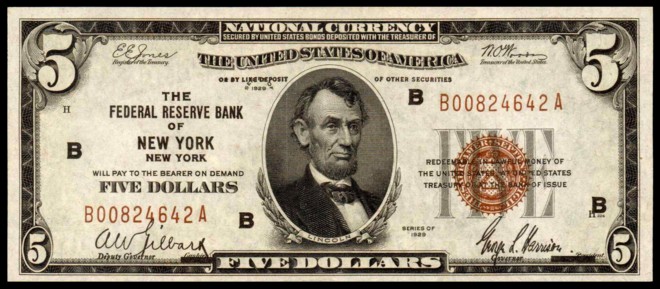

1934 5 Dollars Silver Certificate
Next up is this 1934 Blue Seal Silver Certificate. Though the USA left the gold standard, Silver certificates were widely used, and were legal tender for all debts public and private. This note, with four leading zeros in the serial number would be considered to have a low serial number. Lower serial numbers, or repeating numbers, and other special types are often more desirable to collectors. This note would just be on the edge of being desirable due to the low number.


1934A 5 Dollars Federal Reserve Note “Hawaii”
During WWII it was thought that the Japanese might try to invade the Hawaiian Islands, and as a precautionary measure, the government issued notes specifically for this island chain. Federal Reserve notes were stamped with HAWAII on the left and right of the fronts and a larger stamp on the reverse (the One Dollar bill was a Silver Certificate, as no $1 FRN’s were printed at that time). As a further precautionary measure, the Treasury seal and serial numbers of the notes were colored brown. If the Japanese had invaded Hawaii, the US Government would have been able to easily decree that the Hawaii stamped notes were no longer Legal Tender. These notes were brought home and are still legal tender today, as all government notes are.
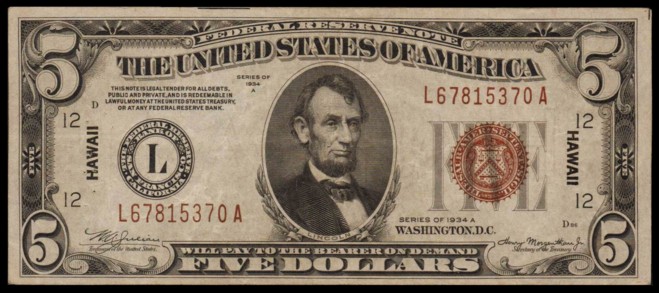
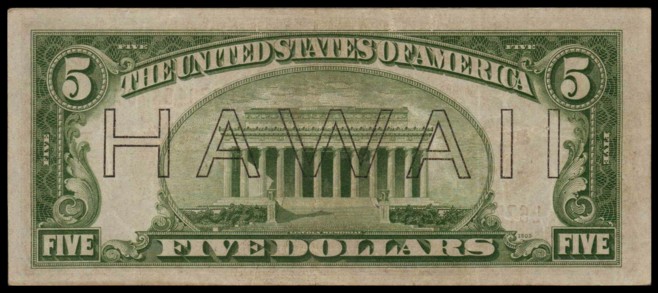
1934A 5 Dollars Silver Certificate “North Africa”
This is a 1934A 5 Dollar Silver Certificate which was issued for military use in North Africa during WWII. The yellow seal and serial numbers were used as a precautionary measure to ensure that if the Axis were to obtain a large amount of these notes in battle, the U.S. could easily declare these notes invalid and keep them from being used by the enemy. These notes were brought home and are still legal tender today, as all government notes are. All the notes issued in North Africa were Silver Certificates.

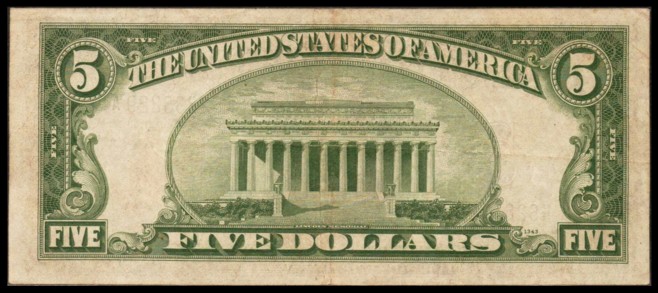
1934 5 Dollars Federal Reserve Note
Unknown to many people, Silver Certificates, US Notes, Federal Reserve Banknotes, Federal Reserve Notes, and others, overlapped in their issues. Today we only have Federal Reserve notes like the one below from 1934, with a green seal and serial numbers which was issued along with the notes above: the U.S. Note which had red seals and serials and the Silver Certificate with blue seals and serial numbers.
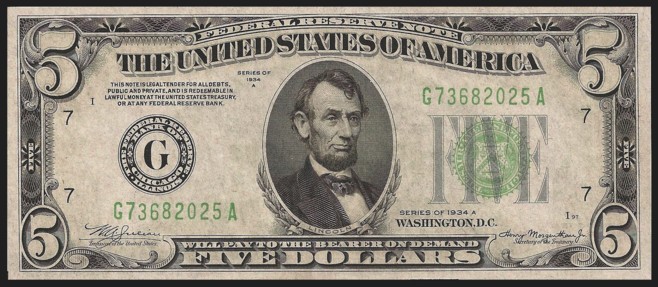
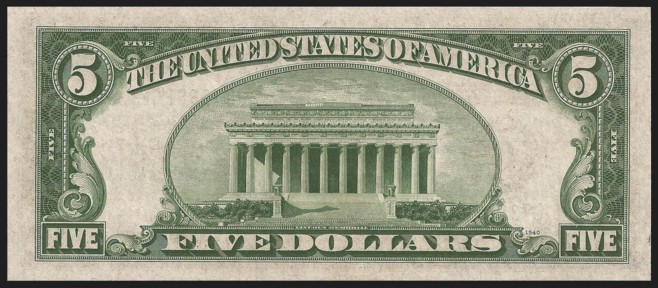
1950 5 Dollars Federal Reserve Note
In 1950 there were some design changes made including the size of the black FRN letter designator seal at left, and the green treasury seal at right with the size of the FIVE over it also reduced. The date on the top left was removed, leaving the one at the bottom right. The text size of the redemption clause was also reduced.


1953 5 Dollars Silver Certificate
This 1953 Silver Certificate had some design changes from the 1934, including a gray 5, smaller seal, change in the placement of the date, etc.

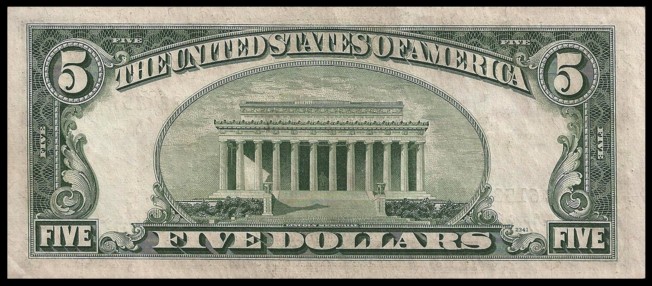
1953 5 Dollars Legal Tender Note
Like the above Silver Cert, the following 1953-B United States (aka Legal Tender) Note had some design changes from the 1934 issue, including a gray 5, smaller seal, change in the placement of the date, etc. This note is also a replacement note, designated by the star in the serial number.
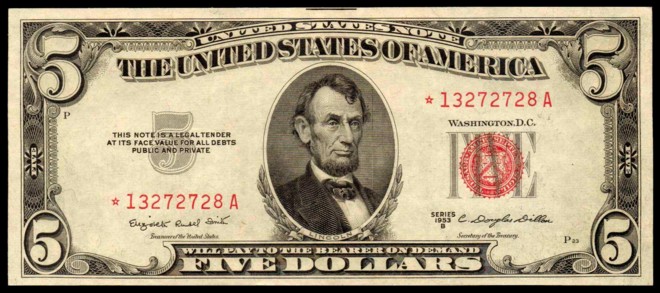

1963 5 Dollars Legal Tender Note
In 1963 the Legal Tender Note added the motto “In God We Trust” on the reverse, located at the top of the oval frame surrounding the Lincoln Memorial.
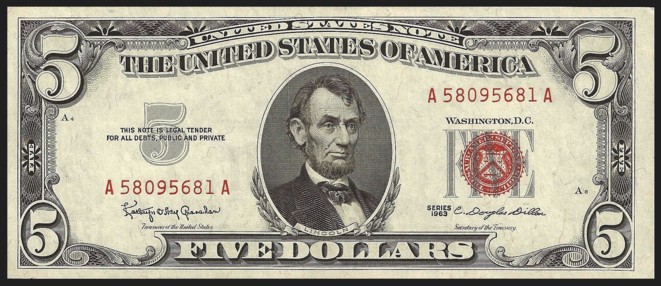

1963 5 Dollars Federal Reserve Note
Issued at the same time as the above, this 1963 Federal reserve note has the familiar green seal and serial numbers.


1969 5 Dollars Federal Reserve Note
This 1969 Federal reserve note has the familiar green seal and serial numbers but is sporting a new design on the green Treasury Seal. They changed over from the old Latin to English in this year. The older Latin phrase was “Thesaur. Amer. Septent. Sigil.” which translates “The Seal of the Treasury of North America.” Since 1969 it has been “The Department of the Treasury 1789.”

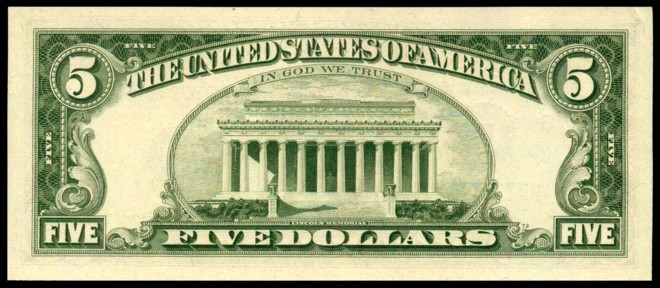
2003 5 Dollars Federal Reserve Note “Big Head”
As time went on, the Bureau of Engraving and Printing decided that the banknotes of the United States needed to be updated with more elements to deter counterfeiting. In 1996 they introduced the new large portrait designs of the 20, 50 and 100 dollar banknotes, and in 1999 the 10 and 5 dollar banknotes were introduced. Here’s the ‘Big-Head’ five introduced in 1999. This design change was primarily done to combat counterfeiting and incorporated a watermark, new security thread and microprint.


2006 5 Dollars Federal Reserve Note “Colorized”
Now we move on to the current colorized Federal Reserve $5. Like the big-heads, the colorized banknotes were primarily made to deter counterfeiters. This $5 note issued in 2006 underwent major design changes, including color shifting inks, watermarks, micro-printing and the EURion pattern of 5 rings based on the placement of the stars in the constellation Orion. These rings are disguised as zeroes in the grouping of several yellow 05’s on the front left and right reverse. The pattern was developed in 2002 for the Euro banknotes and the word is a combination of Euro and Orion.
